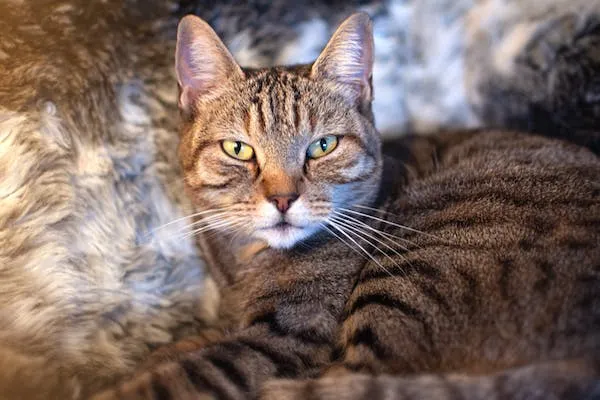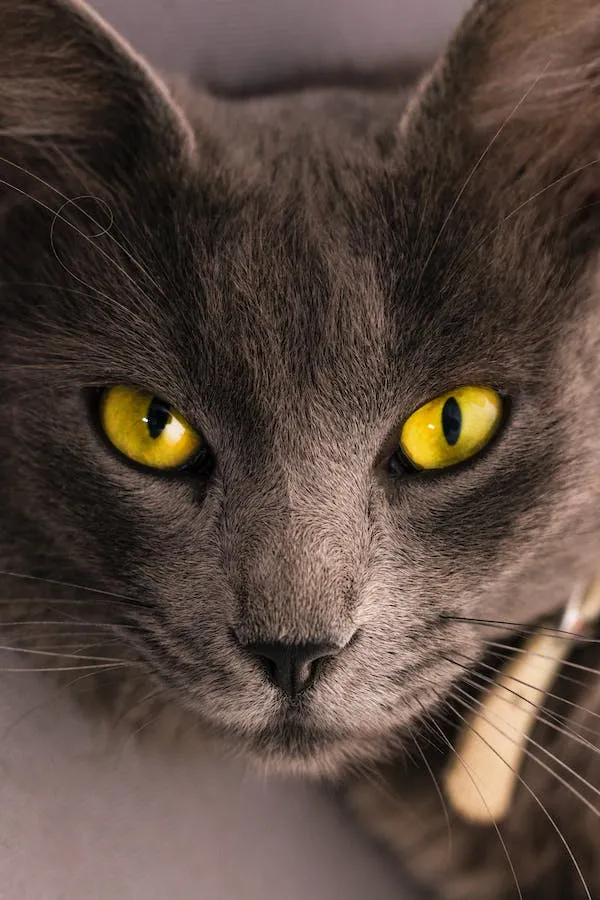Cats have mesmerizing eyes that captivate us with their beauty. However, there are instances when a cat’s eyes may appear cloudy or glassy, which can be concerning for cat owners. This phenomenon, known as glaze over, is indicative of various eye problems that can affect a cat’s vision and overall health. In this article, we will explore the reasons behind cat eye glaze over and discuss the different eye conditions that can cause this issue. We will also provide insights into the symptoms, diagnosis, and treatment options for cat eye problems.
1. Understanding Glaze Over in Cat Eyes
When a cat’s eyes glaze over, it means that they appear cloudy or glassy. This condition is often accompanied by excessive tearing, inflammation, or pain. Glazed-over eyes can be a sign of underlying health issues, and it’s important to address them promptly. If your cat’s eyes remain glazed over for more than 24 hours or if they exhibit other abnormal symptoms, it’s crucial to seek veterinary attention. Glaze over in cat eyes can be a subjective symptom that indicates an imbalance in their internal health.
2. Causes of Glaze Over in Cat Eyes
There are several potential causes for glaze over in cat eyes. It’s essential to identify the underlying issue to provide appropriate treatment. Some common causes of glaze over in cat eyes include:
- Excessive tearing: When a cat’s eyes produce an excessive amount of tears, it can make their eyes appear glassy or cloudy.
- Inflammation: Inflammation in the eyes can lead to glaze over. This inflammation can be caused by various factors such as infections or underlying diseases.
- Eye diseases: There are several eye conditions that can cause glaze over in cat eyes, including corneal ulcers, keratitis, cataracts, and glaucoma.
3. Common Eye Conditions in Cats

3.1 Cloudy Eyes in Cats
Cloudy eyes can be a symptom of various severe eye conditions in cats. While eye diseases are more common in dogs, cats can also be affected. If you notice that your cat’s eyes appear cloudy, it is essential to consult a veterinarian as soon as possible. Cloudy eyes can indicate conditions such as corneal ulcers, keratitis, cataracts, or glaucoma. These conditions require immediate attention to diagnose the underlying cause and preserve your cat’s eyesight.
To determine the cause of cloudy eyes in cats, your veterinarian may perform several tests, including cell culture, corneal stain, microscopic examination of corneal tissue, and tonometry to measure intraocular pressure. The treatment for cloudy eyes will depend on the underlying cause and the severity of the condition. Recovery time can also vary depending on the effectiveness of the treatment and the individual cat’s response. The average cost for treating cloudy eyes in cats ranges from $200 to $2,500.
3.2 Glaucoma in Cats
Glaucoma is a condition characterized by increased pressure inside the eye, which can lead to vision loss and blindness if left untreated. In cats, glaucoma typically starts in one eye but can eventually affect both eyes. There are two types of glaucoma: primary and secondary.
Primary glaucoma is the most common type and usually begins in one eye. Over time, it progresses to involve both eyes and can result in complete blindness. Secondary glaucoma occurs when fluid drainage decreases due to an underlying eye disease, such as chronic retinal detachment, inflammation, uveitis, cataracts, or lens subluxation.
To diagnose glaucoma in cats, a veterinarian measures intraocular pressure. Symptoms of glaucoma in cats include red or cloudy cornea, vision loss, and an enlarging eye due to increased pressure. Unfortunately, permanent blindness often occurs by the time the eyes become enlarged. Treatment options for glaucoma in cats may include medication, surgery, or a combination of both, depending on the severity and underlying cause.
3.3 Cataracts in Cats
Cataracts are another eye condition that can cause glaze over in cats. While cataracts are more common in dogs, cats can also develop this condition. Cataracts occur when the lens of the eye becomes cloudy, impairing vision. Senior cats are more prone to cataracts, and the condition can be caused by genetic susceptibility, inflammation, injury, or underlying eye diseases.
If your cat develops cataracts, it is important to consult a veterinarian for proper diagnosis and treatment. Cataract surgery may be an option to restore vision in cats. The cost of cataract surgery for cats can range from $2700 to $4100, depending on various factors such as the severity of the cataracts, the veterinarian’s fees, and any additional procedures required.
3.4 Keratitis in Cats
Keratitis is a condition characterized by inflammation of the cornea, which can affect a cat’s vision. It can be classified into two types: ulcerative and non-ulcerative keratitis. Various factors, including trauma, infection, inability to close the eyes completely, and feline herpesvirus, can cause keratitis in cats.
The treatment for keratitis in cats typically involves the use of eye drops to reduce inflammation and manage pain. In some cases, surgery may be necessary to address the underlying cause. It is crucial to consult a veterinarian for proper diagnosis and treatment of keratitis in cats.
3.5 Corneal Ulceration in Cats
Corneal ulceration refers to a tear or scratch in the front part of a cat’s eye. Symptoms of corneal ulceration in cats may include pus-like or sticky discharge, increased redness, swelling, and light sensitivity. Corneal ulcers can occur due to various causes, such as injury, infection, or underlying eye diseases.
Treatment for corneal ulcers in cats typically involves the use of antibiotic eye drops for mild cases. In more severe cases, surgery may be necessary to promote healing and prevent complications. It is important to consult a veterinarian if you suspect your cat has a corneal ulcer for proper diagnosis and treatment.

4. Recognizing the Symptoms
It is essential for cat owners to recognize the symptoms of eye problems in their feline companions. Some common signs that may indicate eye issues include:
- Cloudy or glassy appearance of the eyes
- Excessive tearing
- Redness or inflammation
- Swelling around the eyes
- Discharge from the eyes
- Squinting or blinking excessively
- Changes in behavior or mood
- Loss of appetite or energy
- Difficulty finding litter box or navigating in low light
If you notice any of these symptoms, it is crucial to consult a veterinarian for a proper diagnosis and treatment plan.
5. Diagnosis and Treatment
When you take your cat to the veterinarian for eye problems, they will perform a thorough examination to determine the underlying cause. This may involve various tests, including a physical examination, ophthalmic examination, tonometry to measure intraocular pressure, and additional diagnostic procedures such as corneal staining or cell culture.
The treatment for cat eye problems will depend on the specific condition and its severity. It may include medications such as eye drops or ointments to reduce inflammation, manage pain, and treat underlying infections. In some cases, surgery may be necessary to address certain eye conditions, such as cataracts or corneal ulcers.
It is crucial to follow your veterinarian’s instructions carefully and administer the prescribed medications as directed. Regular follow-up visits may be necessary to monitor your cat’s progress and ensure the effectiveness of the treatment.
6. Recovery and Follow-Up
The recovery process for cat eye problems depends on the severity of the condition and the effectiveness of the treatment. Minor corneal ulcers and keratitis may heal within a few days with proper treatment, while infectious ulcers may take longer to resolve. Conditions such as glaucoma or cataracts may require ongoing management and follow-up visits to monitor your cat’s vision and overall eye health.
During the recovery period, it is important to provide a comfortable and stress-free environment for your cat. Ensure that they have access to clean water, nutritious food, and a litter box. If necessary, administer medications as prescribed and monitor their behavior, appetite, and energy levels. If you notice any changes or worsening of symptoms, contact your veterinarian immediately.
7. Frequently Asked Questions
Q1. Can a cat’s cloudy eye heal on its own? A1: A cat’s cloudy eye cannot heal on its own. Cloudy eyes are indicative of several eye diseases, including corneal ulcers, keratitis, cataracts, and glaucoma. Proper veterinary treatment is required to prevent further complications and preserve your cat’s vision.
Q2. Why does one of my cat’s eyes look glassy? A2: One of the reasons a cat’s eye may look glassy is excessive tearing and inflammation. If you notice glassy eyes in your cat, it is crucial to seek veterinary attention as soon as possible.
Q3. What are the symptoms of a cat going blind? A3: Some symptoms of a cat going blind may include cloudy eyes, wide pupils, difficulty navigating in low light, behavioral changes, and trouble finding the litter box. If you suspect your cat is experiencing vision loss, it is important to consult a veterinarian for a proper diagnosis.
Q4. Can cat blindness be reversed? A4: While proper veterinary treatment can sometimes preserve partial vision in cats with retinal detachment, most cases of cat blindness are irreversible. Early detection and treatment are essential to slow down the progression of eye conditions and preserve your cat’s remaining vision.
Q5. Is cat conjunctivitis an emergency? A5: Mild cases of conjunctivitis in cats may resolve on their own. However, if your cat exhibits severe eye conditions or if the symptoms persist or worsen, it is advisable to seek veterinary care. Prompt treatment can prevent complications and ensure a speedy recovery.
Q6. What are the causes of eye problems in kittens? A6: Eye problems such as glazed-over or cloudy eyes in kittens can be caused by various factors, including viral infections, conjunctivitis, feline herpes, keratitis, uveitis, and blepharitis. It is important to provide proper veterinary care to diagnose and treat these conditions effectively.
conclusion
In conclusion, glaze over in cat eyes is a concerning symptom that can indicate underlying eye problems. It is crucial for cat owners to be aware of the potential causes, symptoms, and treatment options for cat eye problems. By seeking prompt veterinary care and following the recommended treatment plan, you can help preserve your cat’s vision and ensure their overall well-being.
Why is My Siamese Cat Losing Weight?
Beige Cream Cat Breeds: Elegance and Personality


